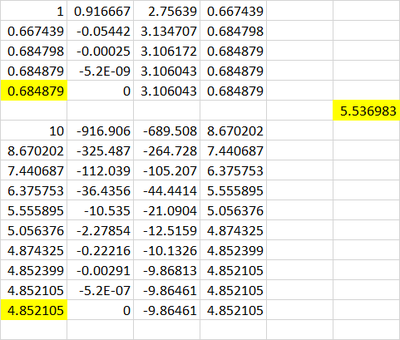Power Functions - Find Where they Equate on Interval
{ f ( x ) = x a + x b + x c + x d g ( x ) = a x + b x + c x + d x
Functions f ( x ) and g ( x ) are defined as above, where a = 3 1 , b = 2 1 , c = 4 1 , and d = 2 , are continuous on x ∈ [ 0 , 1 0 ] and f ( x ) = g ( x ) at two points x 1 and x 2 . Find x 1 + x 2 to the nearest 1 / 1 0 0 th.
The answer is 5.54.
This section requires Javascript.
You are seeing this because something didn't load right. We suggest you, (a) try
refreshing the page, (b) enabling javascript if it is disabled on your browser and,
finally, (c)
loading the
non-javascript version of this page
. We're sorry about the hassle.
3 solutions
Using Newton-Raphson method x n + 1 = x n − f ′ ( x ) f ( x ) with an Excel spreadsheet. x 1 ≈ 0 . 6 8 4 8 7 8 7 5 6 , x 2 ≈ 4 . 8 5 2 1 0 4 6 9 , and x 1 + x 2 ≈ 5 . 5 3 6 9 8 3 4 4 5 ≈ 5 . 5 4 .

Here's a hand-coded Newton Raphson algorithm. The function I call f is the difference between the two functions given in the problem.